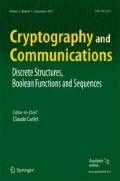Abstract
Nowadays it is vital to have a robust mechanism that can identify people, objects, animals, and living beings, for example, for agricultural, health and national security purposes. Some drawbacks occur when very many objects need to be identified, and the tool is unable to support all of them. Even if the mechanism could tag them all, it is also important that the labels or codewords not resemble each other, to be able to detect and correct errors. To solve this problem, this article proposes an MDS (Maximum Distance Separable) code C with length 11 and dimension 7 over the finite field \({\mathbb {F}}_{2^{10}}\). Furthermore, we construct a subcode of C with capacity for 327 different identifiers. Concretely we consider the set of all codewords with entries belonging to the subfield of \({\mathbb {F}}_{2^{10}}\) isomorphic to \({\mathbb {F}}_{2^{5}}\). A decoding algorithm and an encryption method using elliptic curves cryptography for the codewords are also proposed.
Similar content being viewed by others
References
Alhaqbani, B., Fidge, C.J.: Privacy-preserving electronic health record linkage using pseudonym identifiers. In: 10th IEEE international conference on e-health networking, applications and services. HealthCom, Singapore, Singapore, pp 108–117 (2008)
Baker, D.: The joint commission’s 2017 national patient safety goals, Available from: https://www.jointcommission.org/npsg_presentation/, (accessed 17 July 2017) (2017)
Bernstein, D., Lange, T.: Safecurves, Available from: http://safecurves.cr.yp.to, (accessed 17 July 2017) (2014)
Bosma, W., Cannon, J., Playoust, C.: The Magma algebra system. I. The user language. J. Symbolic Comput. 24(3-4), 235–265 (1997). Computational algebra and number theory (London, 1993). MR MR1484478
Dewaghe, L.: Remarks on the schoof-elkies-atkin algorithm. Math. Comput. American Math. Soc. 67(223), 1247–1252 (1998)
Faldum, A., Pommerening, K.: An optimal code for patient identifiers. Comput. Meth. Programs Biomed. 79, 81–88 (2005)
IEEE P1363 Working Group: Standard specifications for public-key cryptography, Available from: http://grouper.ieee.org/groups/1363/, (accessed 17 July 2017) (2001)
Gutierrez, I., Willems, W.: Una introducción a la criptografía de clave pública, 2 edn. Ediciones Uninorte (2008)
Huffman, W.C., Pless, V.: Fundamentals of error-correcting codes. Cambridge University Press, Cambridge (2003)
Kraft, J.S., Washington, L.C.: An introduction to number theory with cryptography. CRC Press, Boca Raton (2013)
Lee, Y.J., Lee, K.H.: Re-identification of medical records by optimum quasi-identifiers. In: 19th International Conference on Advanced Communication Technology (ICACT), Bongpyeong, South Korea, pp 428–435 (2017)
Lochter, M., Merkle, J.: Ecc brainpool standard curves and curve generation, Available from: http://www.ecc-brainpool.org/download/Domain-parameters.pdf, (accessed 17 July 2017) (2010)
MacWilliams, F.J., Sloane, N.J.A.: The theory of error-correcting codes. 1st edn. North-Holland Mathematical Library, Amsterdam (1998)
Molina, I.: A maximum distance separable code to generate universal identifiers, Tesis De Maestría, Universidad Del Norte, Barranquilla, Colombia (2016)
World Health Organization, Patient identification: Patient safety solutions, Available from: http://www.who.int/patientsafety/solutions/patientsafety/PS-Solution2.pdf, (accessed 17 July 2017) (2007)
Ryabko, B., Fionov, A.: Basics of contemporary cryptography for IT practitioners, vol. 1 World Scientific (2005)
Siemens: European green city index, Available from: https://www.siemens.com/entry/cc/features/greencityindex_international/all/en/pdf/report_en.pdf, (accessed 17 July 2017) (2009)
Stein, W.: Sagemath, Available from: http://www.sagemath.org/index.html, (accessed 17 July 2017) (2005)
Taneja, H., Singh, A.K.: Preserving privacy of patients based on reidentification risk. Procedia Comput. Sci. 70, 448–454 (2015)
Thomas, P., Evans, C.: An identity crisis? aspects of patient misidentification. Clinical Risk 10(1), 18–22 (2004)
Trappe, W., Washington, L., Anshel, M., Boklan, K.D.: Introduction to cryptography with coding theory. Math. Intell. 29(3), 66–69 (2007)
Author information
Authors and Affiliations
Corresponding author
Additional information
Publisher’s note
Springer Nature remains neutral with regard to jurisdictional claims in published maps and institutional affiliations.
Rights and permissions
About this article
Cite this article
García, I.G., Molinares, D.J. & Naizir, I.M. A novel maximum distance separable code to generate universal identifiers. Cryptogr. Commun. 11, 1021–1035 (2019). https://doi.org/10.1007/s12095-018-0346-x
Received:
Accepted:
Published:
Issue Date:
DOI: https://doi.org/10.1007/s12095-018-0346-x
Keywords
- Finite fields
- Binary linear codes
- MDS-code
- Maximum distance separable
- Information theory
- Elliptic curve cryptosystem
- Identifiers
- Error correction
- Error detection




